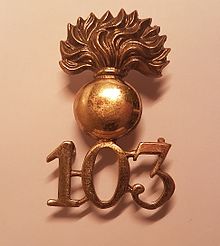103rd Foot
| 103rd Regiment of Foot (Royal Bombay Fusiliers) | |
|---|---|

Cap badge of the 103rd Regiment of Foot (Royal Bombay Fusiliers)
|
|
| Active | 1662–1881 |
| Country |
|
| Branch |
|
| Role | Infantry |
| Size | One battalion |
| Garrison/HQ | Naas Barracks, County Kildare |
| Colors | white facings, changed to dark blue in 1861. |
| Engagements |
Seven Years' War Third Anglo-Mysore War Third Anglo-Maratha War Fourth Anglo-Mysore War Second Anglo-Sikh War Indian Rebellion |
The 103rd Regiment of Foot (Royal Bombay Fusiliers) was a regiment raised in 1662. It transferred to the command of the Honourable East India Company in 1668 and to the command of the British Army in 1862. Under the Childers Reforms it amalgamated with the 102nd Regiment of Foot (Royal Madras Fusiliers) to form the Royal Dublin Fusiliers in 1881.
The regiment was originally raised in England as independent companies of European soldiers to garrison Bombay in February 1662. It embarked for India later that year and was transferred to the Honourable East India Company as The Bombay Regiment in March 1668. In 1688 it was renamed The Bombay (European) Regiment – "European" indicating it was composed of white soldiers, not Indian sepoys. The regiment saw action at the Battle of Plassey in June 1757 during the Seven Years' War. It also fought at the Battle of Buxar in October 1764 during the Oude Campaign. It next saw action at the Siege of Seringapatam in February 1792 during the Third Anglo-Mysore War. It fought at the Battle of Seedaseer in March 1799 and the Siege of Seringapatam in April 1799 during the Fourth Anglo-Mysore War.
The regiment fought at the Battle of Khadki in November 1817 during the Third Anglo-Maratha War. It then embarked for the Arabian Peninsula in October 1820 and saw action in operations against Omani pirates at Jalan Bani Bu Ali in March 1821.
...
Wikipedia
